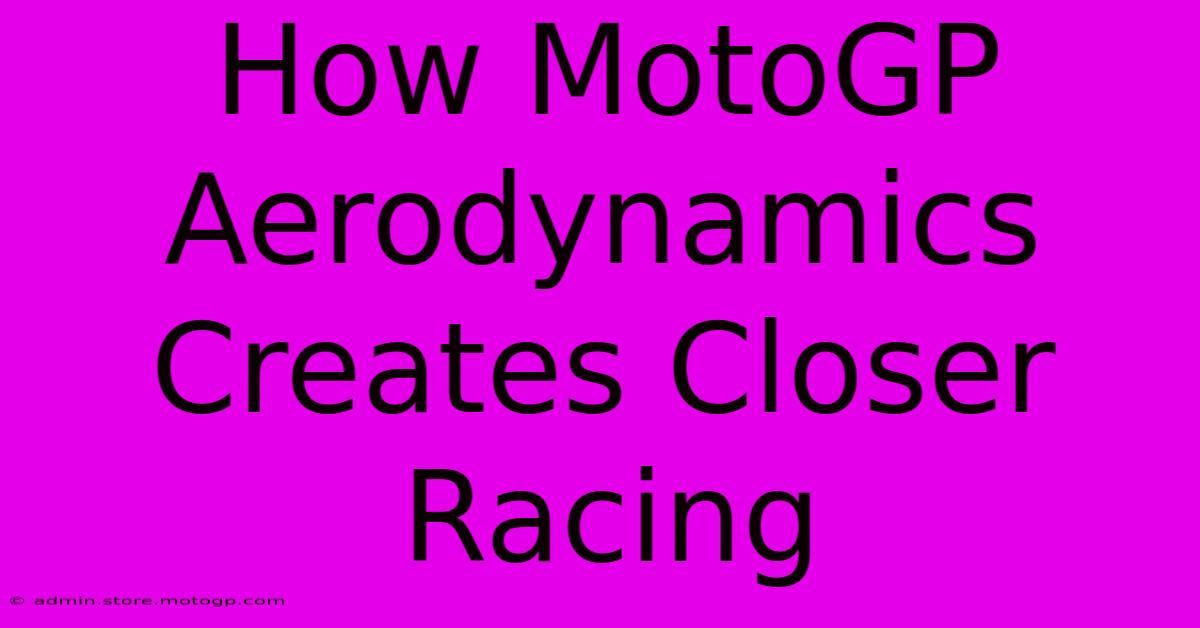How MotoGP Aerodynamics Creates Closer Racing

Table of Contents
How MotoGP Aerodynamics Creates Closer Racing
MotoGP, the pinnacle of motorcycle road racing, is a spectacle of speed, skill, and incredibly close competition. While rider talent is paramount, the subtle yet significant advancements in aerodynamics play a crucial role in creating the thrilling wheel-to-wheel battles we witness each race weekend. This article delves into how aerodynamic developments have not only increased top speeds but also, surprisingly, contributed to closer racing.
The Aerodynamic Arms Race: From Wings to Winglets
For years, MotoGP bikes were relatively simple aerodynamically. But as speeds increased, so did the need for downforce. This led to the introduction of aerodynamic wings and winglets, initially met with some controversy. These weren't just for show; they provided significant benefits.
Increased Downforce, Improved Stability
The primary function of these aerodynamic devices is to generate downforce, pressing the bike firmly onto the track. This increased grip at high speeds allows riders to:
- Lean further into corners: Greater downforce means more traction, enabling riders to carry more speed through turns.
- Brake later and harder: With improved stability, riders can delay braking points, gaining precious milliseconds.
- Accelerate sooner and more aggressively: The increased grip allows for more powerful acceleration out of corners.
The Unexpected Consequence: Closer Racing
While the increased performance is obvious, the impact on racing dynamics is less intuitive. The improved stability and handling afforded by advanced aerodynamics have a cascading effect:
- Reduced reliance on slipstreaming: In the past, slipstreaming was crucial for overtaking, as it significantly reduced aerodynamic drag. While still important, modern aerodynamic packages make it easier for riders to overtake on their own merit, leading to more varied and unpredictable racing lines.
- More consistent lap times: The improved stability translates to more consistent lap times, even under intense racing conditions. This means riders are closer together for longer periods, increasing the potential for exciting battles.
- Improved overtaking opportunities: The ability to carry more speed through corners opens up more overtaking opportunities, as riders can maintain higher speeds on the exits, making it easier to close on the rider ahead.
The Balancing Act: Aerodynamic Regulations
The governing body, Dorna Sports, constantly fine-tunes the aerodynamic regulations to ensure a balance between performance and safety. These regulations:
- Limit the size and shape of aerodynamic devices: This prevents teams from creating excessively dominant aerodynamic packages.
- Conduct rigorous testing: Dorna employs sophisticated wind tunnel testing to evaluate the performance of different aerodynamic designs.
- Introduce new rules periodically: These rules are designed to keep innovation in check and encourage balanced competition.
This constant adjustment and refinement of aerodynamic rules is vital in maintaining close racing and preventing one team or rider from dominating through sheer aerodynamic advantage.
The Future of Aerodynamics in MotoGP
The development of aerodynamics in MotoGP is an ongoing process. We can expect continued innovation and refinement of aerodynamic designs, pushing the boundaries of performance and leading to even more exciting and unpredictable racing. The constant quest for marginal gains in aerodynamic efficiency will undoubtedly play a defining role in shaping the future of this exhilarating sport.
In conclusion, while initially intended to boost top speed and cornering stability, aerodynamic advancements in MotoGP have surprisingly resulted in closer and more competitive racing. The constant evolution of aerodynamic regulations ensures that this thrilling competition continues to captivate audiences worldwide.

Thank you for visiting our website wich cover about How MotoGP Aerodynamics Creates Closer Racing. We hope the information provided has been useful to you. Feel free to contact us if you have any questions or need further assistance. See you next time and dont miss to bookmark.
Featured Posts
-
Us Grand Prix Sprint Time A Battle Against The Seconds
Feb 18, 2025
-
Beyond The Podium The Lives Of Motorcycle Grand Prix Winners
Feb 18, 2025
-
Experience The Roar Cota Circuit Days
Feb 18, 2025
-
Maximize Your Moto Gp Viewing Experience Understand The Points
Feb 18, 2025
-
Inside The Us Grand Prix Sprint Time Secrets
Feb 18, 2025
